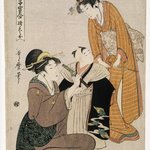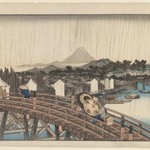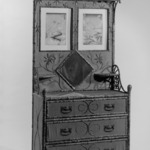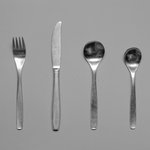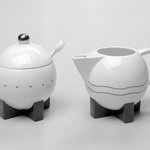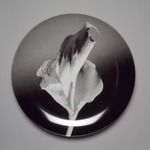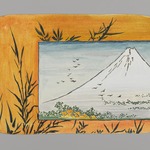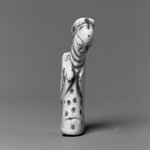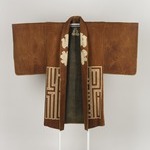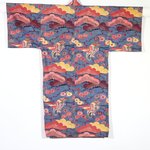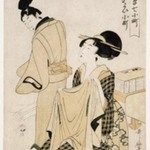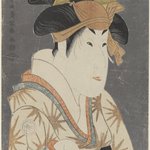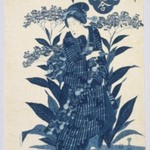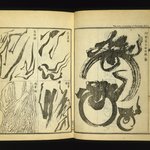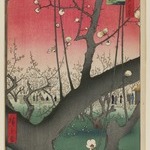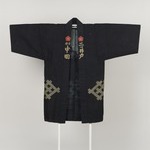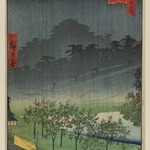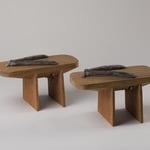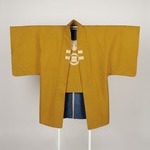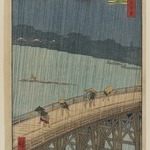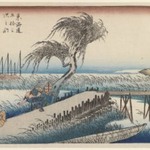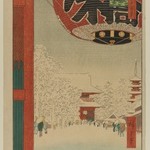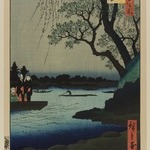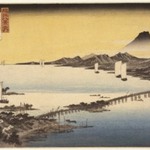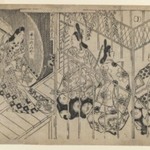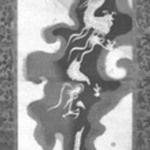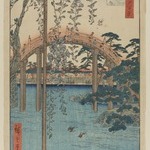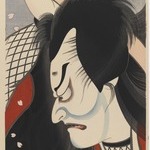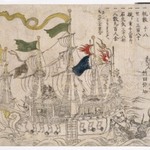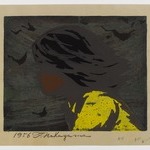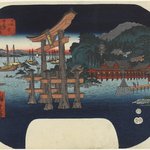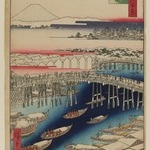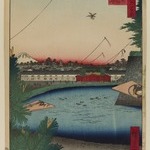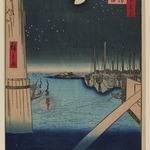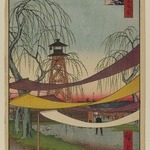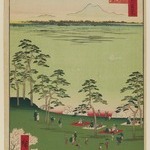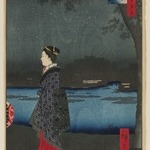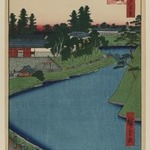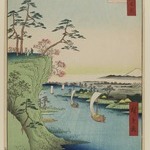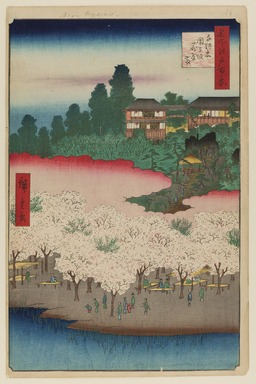
Flower Pavilion, Dango Slope, Sendagi, No. 16 in One Hundred Famous Views of Edo
Utagawa Hiroshige
Asian Art
A bank of decorative clouds separates this print into two seemingly different worlds—a lofty, mountain like retreat and a familiar scene of cherry viewing along a pond or river. The identification of the upper scene is clear enough from the title: it is the Flower Pavilion, a former nurseryman's garden opened to the public for seasonal flower viewing and described on an 1852 map as a "pavilion for all four seasons."
Why did Hiroshige divide the scene? Perhaps he intended to show autumn above and spring below, emphasizing that the garden was indeed "for all four seasons."
MEDIUM
Woodblock print
DATES
5th month of 1856
PERIOD
Edo Period, Ansei Era
DIMENSIONS
Image: 13 1/2 x 8 7/8 in. (34.3 x 22.5 cm)
Sheet: 14 3/16 x 9 1/4 in. (36 x 23.5 cm) (show scale)



MARKINGS
No publisher's censor or date seals visible, probably lost when left edge was trimmed.
SIGNATURE
Hiroshige-ga
COLLECTIONS
Asian Art
ACCESSION NUMBER
30.1478.16
CREDIT LINE
Gift of Anna Ferris
PROVENANCE
Prior to 1930, provenance not yet documented; by 1930, acquired by Anna Ferris of Summit, NJ; 1930, gift of Anna Ferris to the Brooklyn Museum.
Provenance FAQ
CATALOGUE DESCRIPTION
Cherry viewing in the "Flower Pavilion," identified as the Shinsentei (Purple Fountain pavilion), described on an 1852 Kiriezu map as a "shiki hanayashiki" or "flower pavilion for all four seasons." The scene above is one a deep, rich greens, with three small figures climbing through a craggy garden up to a bright pavilion, while below visitors of all classes stroll among the cherries and rest on teahouse benches. It is noted that the Flower Pavilion building was a rarity for its three storey height and popularly known as the "Outlook" (Miharashi) for the spectacular view which it offered of Ueno and Shinobazu Pond to the southwest. Little figures can be seen peering out from the windows of the lofty pavilion. It is possible that Hiroshige intended to show two different seasons here, perhaps autumn above and spring below, emphasizing that it was indeed a "flower pavilion for all four seasons." According to Ishii Kendo's commentary of 1919, the Shisentei was founded by a gardener named Kusuda Uheiji and covered an area of two and a half acres. By the time Ishii was writing in 1919, however, the original garden had been closed to public viewing and the land sold off into lots for private homes.
EXHIBITIONS
MUSEUM LOCATION
This item is not on view
CAPTION
Utagawa Hiroshige (Japanese, 1797–1858). Flower Pavilion, Dango Slope, Sendagi, No. 16 in One Hundred Famous Views of Edo, 5th month of 1856. Woodblock print, Image: 13 1/2 x 8 7/8 in. (34.3 x 22.5 cm). Brooklyn Museum, Gift of Anna Ferris, 30.1478.16 (Photo: Brooklyn Museum, 30.1478.16_PS20.jpg)
IMAGE
overall, 30.1478.16_PS20.jpg. Brooklyn Museum photograph, 2023
"CUR" at the beginning of an image file name means that the image was created by a curatorial staff member. These study images may be digital point-and-shoot photographs, when we don\'t yet have high-quality studio photography, or they may be scans of older negatives, slides, or photographic prints, providing historical documentation of the object.
RIGHTS STATEMENT
No known copyright restrictions
This work may be in the public domain in the United States. Works created by United States and non-United States nationals published prior to 1923 are in the public domain, subject to the terms of any applicable treaty or agreement.
You may download and use Brooklyn Museum images of this work. Please include caption information from this page and credit the Brooklyn Museum. If you need a high resolution file, please fill out our online application form (charges apply).
The Museum does not warrant that the use of this work will not infringe on the rights of third parties, such as artists or artists' heirs holding the rights to the work. It is your responsibility to determine and satisfy copyright or other use restrictions before copying, transmitting, or making other use of protected items beyond that allowed by "fair use," as such term is understood under the United States Copyright Act.
The Brooklyn Museum makes no representations or warranties with respect to the application or terms of any international agreement governing copyright protection in the United States for works created by foreign nationals.
For further information about copyright, we recommend resources at the United States Library of Congress, Cornell University, Copyright and Cultural Institutions: Guidelines for U.S. Libraries, Archives, and Museums, and Copyright Watch.
For more information about the Museum's rights project, including how rights types are assigned, please see our blog posts on copyright.
If you have any information regarding this work and rights to it, please contact copyright@brooklynmuseum.org.
RECORD COMPLETENESS
Not every record you will find here is complete. More information is available for some works than for others, and some entries have been updated more recently. Records are frequently reviewed and revised, and we welcome any additional information you might have.
